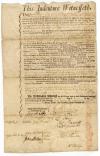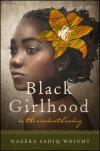Childhood Studies

|
Good Wishes for the Children Rediscovered: Hans Christian Andersen and the Launch of Sarah Gooll Putnam’s Artistic Career | In the course of her work at AAS, Laura Wasowicz, the Society's curator of children's literature, recovered the identities of the translator and illustrator of Good Wishes for the Children, a compilation of Hans Christian Andersen stories published in a limited, high-end edition by the Riverside Press in 1873 as a fundraiser for Boston Children’s Hospital. The illustrator was Sarah Gooll Putnam (1851–1912), an upper-class Bostonian who eventually enjoyed a successful career as a portraitist. This ambitious project was spearheaded by Putnam’s friend Adeline A. |

|
Black Boys, Dolls, and Textual Histories: Alice Dunbar-Nelson’s “His Heart’s Desire” (1900) | This virtual forum features Jean Lutes, Denise Burgher, Trinity Rogers, and Brigitte Fielder of Taught by Literature, a collaborative digital humanities project that re-centers Black women writers, beginning with the work of African American author and activist Alice Dunbar-Nelson. |

|
19th Century American Children’s Book Trade Directory | Based upon the unparalleled collection of Children's Literature held at the American Antiquarian Society, this comprehensive directory contains 2,600 entries documenting the activity of individuals and firms involved in the manufacture and distribution of childrens books in the United States chiefly between 1821 and 1876. |
| 'The Bank of Industry’: Rewards of Merit and the ‘Emotional Capitalism’ of Nineteenth-Century Schoolroom Ephemera | AAS member Patricia Crain (elected 2002) returns to the AAS reading room to discuss her latest book, Reading Children: Literacy, Property, and the Dilemmas of Childhood in Nineteenth-Century America. This work explores what it meant for a child to be a "reader" and how American culture came to place such a high value on this identity. Crain conducted the research for Reading Children at AAS when she was an AAS-NEH fellow in the 2005-06 academic year. |
|

|
Isaiah Thomas’s Apprenticeship: The Labor and Value of Children’s Literature | When the Worcester, Massachusetts, printer Isaiah Thomas (1749–1831) donated his collection of early American imprints to found the American Antiquarian Society, he did not include in that donation many books written for children. Yet Thomas was the foremost publisher of children’s literature in his time, and books addressed to child readers at school or at home generated at least a quarter of his press profits. Isaiah Thomas’s own accounts of his career always emphasized his experience as a printer’s apprentice, beginning to set type when he was only six years old. |

|
Stolen: Five Free Boys Kidnapped into Slavery and their Astonishing Odyssey Home | In this talk, Richard Bell will discuss his new book, Stolen, a gripping and true story about five young, free black boys who were kidnapped in the North in 1825 and smuggled into slavery in the Deep South—and their daring attempt to escape and bring their captors to justice. |
| Traumas and Triumphs: A Roundtable on the History of Black Childhood | Join us for a roundtable discussion on the history of Black childhood. Moderated by Nazera Wright (University of Kentucky), this program brings together Kabria Baumgartner (Northeastern University) and Crystal Webster (University of British Columbia), who share their own research on the subject. Participants will discuss the threats and challenges facing African American children in the nineteenth century, as well as the ways in which they wrote, organized, and forged their own individual and collective identities. |
|

|
Black Girlhood in the Nineteenth Century | Scholars have explored how nineteenth-century scrapbooks and friendship albums circulated among free black women in the North to showcase their middle-class status and close networks. However, little is known about how black girls participated in this sentimental practice. In this lecture, Nazera Sadiq Wright will discuss how histories of black girlhood are often “buried” in literary genres less likely to be studied. Recovering these histories involves using types of literature that move beyond the bound book. |
| Ruth Henshaw Bascom diary, 1789-1793 | Ruth Henshaw Bascom (1772-1848) was born in Leicester, Mass., the daughter of William (1735-1820) and Phebe Swan Henshaw (1753-1808). Her father was an influential Leicester resident, and Ruth Henshaw grew up as a member of a large and very active family. In 1804 she married Dr. Asa Miles (1762-1805), a physician who had graduated from Dartmouth College. They lived in Westminster, Mass., until his death, after which she returned to her family in Leicester. In 1806 she married the Rev. Ezekiel Lysander Bascom (1779-1841). |
|

|
Reading Children | Led by Patricia Crain What does it mean to be a child reader in pre-1900 America? This seminar, hosted by the Program in the History of the Book in American Culture at the American Antiquarian Society, will guide inquiries into the question: What does it mean to be a child reader in pre-1900 America? The holdings of the AAS in artifacts of childhood number over 26,000 objects, and thus provide a unique laboratory for thinking about the changing ideas of childhood and the child reader from the seventeenth through the nineteenth century. |